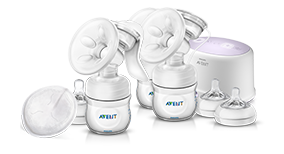Reading Time: 5 Min
How to pump milk (if you need to)
Many mothers can’t wait to start pumping, but it is generally recommended to wait until baby is one month old. This gives your body a chance to establish a milk supply exactly matching your baby’s needs, and saves you from the extra work pumping entails.
Why pump or extract milk
1. Baby doesn’t gain enough weight
It is time for pumping if your healthcare provider tells you the milk supply needs to be increased. Some babies can’t get all the milk due to be born prematurely or with a low birth weight. They need to get pampered with extra milk. In this case, you would pump daily after every feeding for 5-10 minutes. You can mix milk from the same day together in the same storage bag or bottle. Make sure you write the date on the outside.
2. Your nipples or breasts hurt a lot
If you can’t have your baby on your breast due to nipple pain, you can pump milk and feed it with a cup or spoon. Talk to a lactation consultant to check on baby’s latch. In a few days you should be able to breastfeed again.
If your breasts hurt from engorgement when your milk first comes in, you can pump just enough to soften your breasts (but not so much that it fools your body into continuing to produce too much milk).
3. You are not allowed to breastfeed
If you have an infection like hepatitis, a syphilitic lesion or HIV, you won’t be allowed to breastfeed your baby. In this case, you could look into providing breast milk to your baby from a human milk bank, which exists in many countries. The WHO recommends milk banks as the first option before giving formula which only has 40 ingredients versus over 200 that breast milk has. Also formula is based on cow’s milk, which some babies don’t tolerate.
How to choose a pump
Once you bought your pump, make sure you read the manufacturer’s instructions before you use it. Most pumps need to be sterilized before use which can take a few hours. If you are using a rental grade pump, you should have your own personal pump kit. Do not share a pump unless it’s in the hospital and the staff exchanges all the tubes.
Things to consider before you buy a pump:
How to start pumping
Storage and feeding pumped breast milk
If you will feed this milk within the next four hours, you can leave it out and feed it at room temperature. Otherwise refrigerate it for up to four days and if you still haven’t used it by then, freeze it.
Feeding expressed milk to your baby
First, consider cup feeding over bottle feeding. There is no bottle nipple that is most like the breast. Babies who are bottle fed (with either formula or expressed milk) may alter self-regulation of intake, contributing to later obesity, and may begin to prefer the feel and flow of the bottle nipple (as opposed to mom’s softer nipple).




